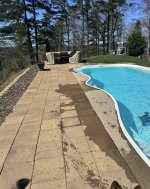An almost 10 year process - finally , hopefully, finishing pool decking, etc. Currently we have exposed pool equipment on the north end of our pool. Finally able to finish the backyard project with decking and a roofed kitchen/ pool house / bar area. It would seem that this enclosed area is going to be much better to be located on the South side.
In an effort to have our pool equipment covered (and unexposed visually to our driveway) it would be better to have the pool equipment moved from North to South and in the newly built enclosure. Rather than digging up lots of very solid ground all the way around the pool it would seem easier to just run a single (or even all 3) 2 inch flexible PVC inflow line connected at the north side back to the south side new equipment location. And a single (or 3 outflow - 2 deep and 1 skimmer) 2 inch flexible PVC for the pool outflow.
If we did single lines it would probably add 50 ft of distance
I have attached photos to give a better visual
Any thoughts?




In an effort to have our pool equipment covered (and unexposed visually to our driveway) it would be better to have the pool equipment moved from North to South and in the newly built enclosure. Rather than digging up lots of very solid ground all the way around the pool it would seem easier to just run a single (or even all 3) 2 inch flexible PVC inflow line connected at the north side back to the south side new equipment location. And a single (or 3 outflow - 2 deep and 1 skimmer) 2 inch flexible PVC for the pool outflow.
If we did single lines it would probably add 50 ft of distance
I have attached photos to give a better visual
Any thoughts?




Last edited by a moderator:







